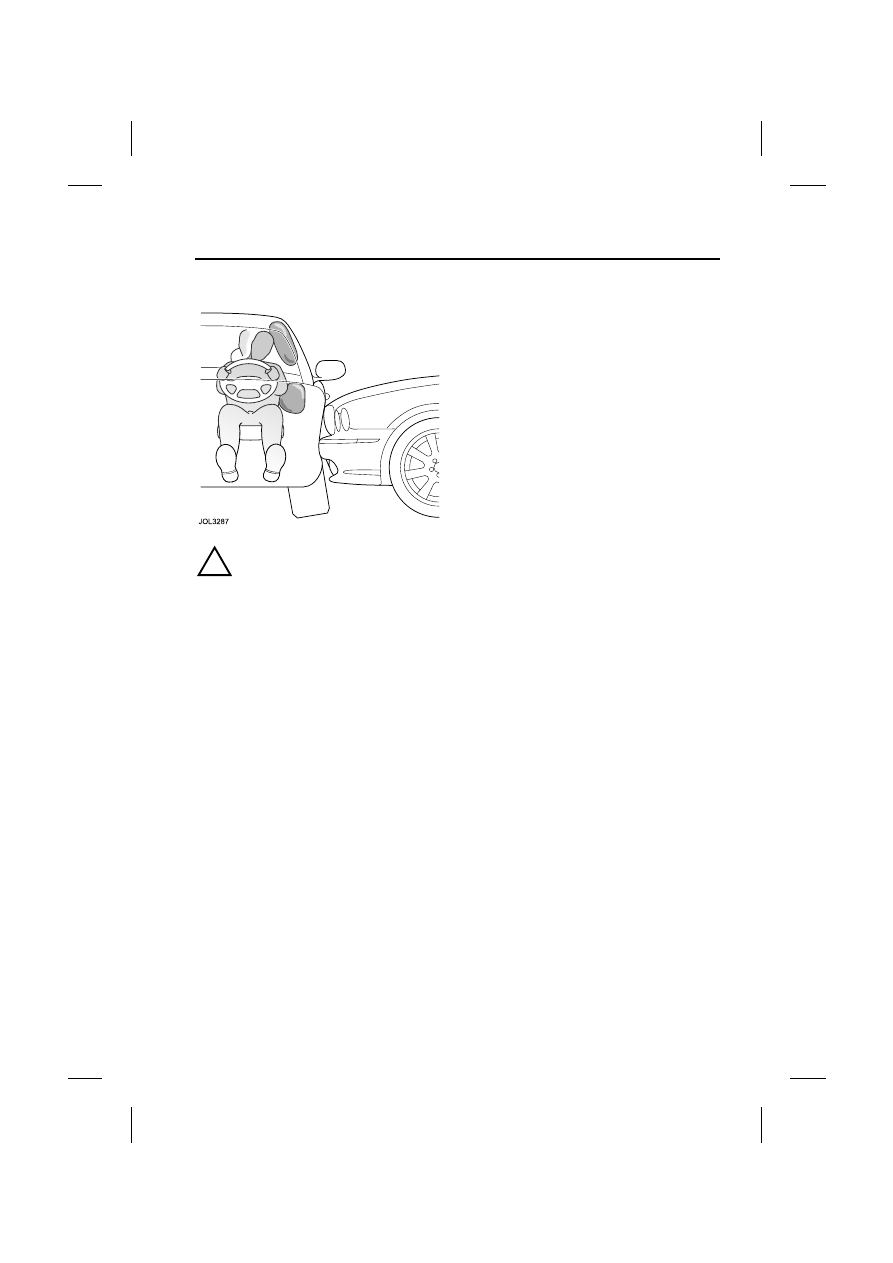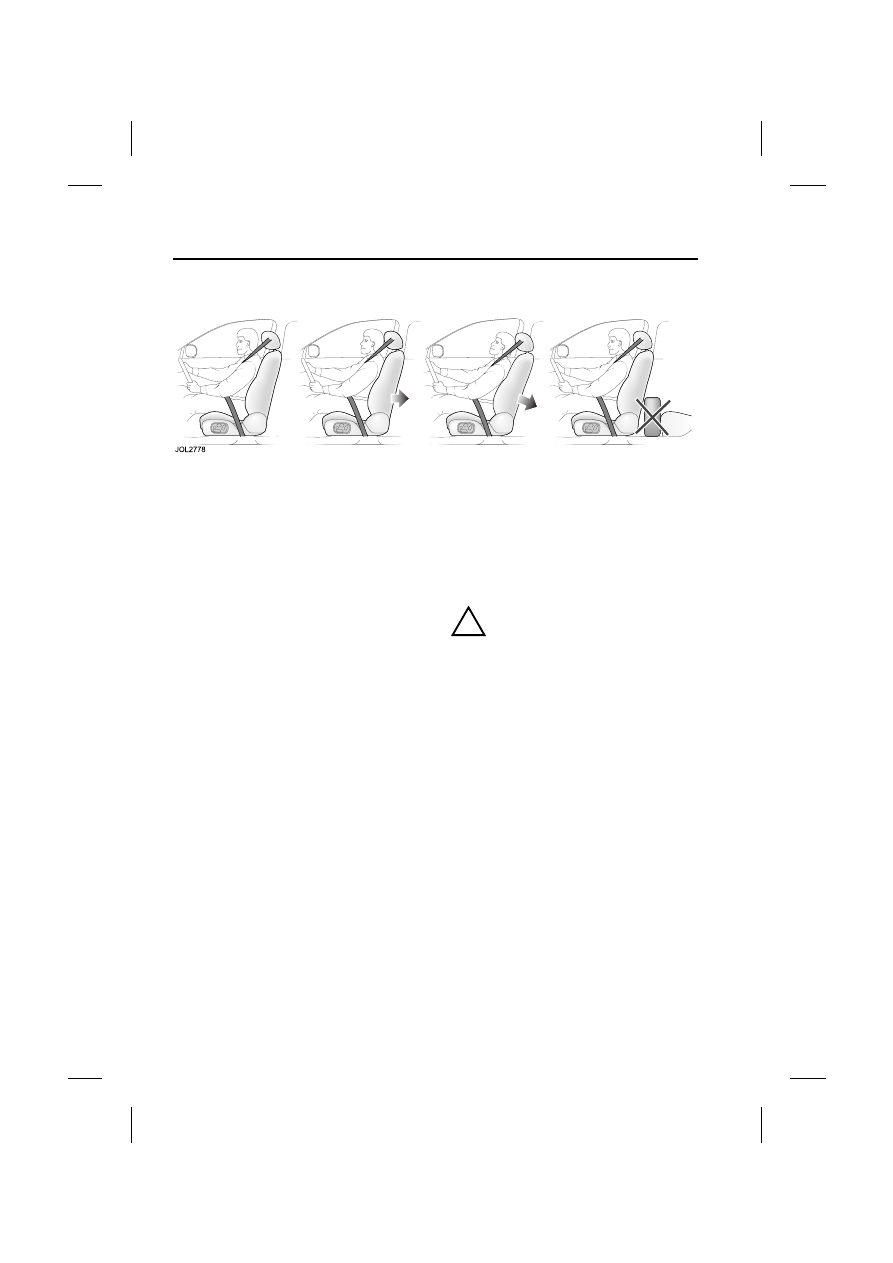Jaguar S-Type. Manual — part 14

61
Occupant Protection
R
Air bag deployment
The air bag supplementary restraint
system incorporates front, side thorax
and side head air bags for the driver and
front passenger and side head bags for
rear seat passengers. These are indicated
by the word AIR BAG on the trim. They are
used in conjunction with the seat belts to
help protect occupants from upper body
(thorax) and head injuries.
1. The driver front air bag is located in
the center of the steering wheel.
2. The front passenger air bag is located
in the facia panel immediately in front
of the passenger seat.
3. Curtain air bags are fitted on each
side, above the front and rear doors.
4. Thorax side air bags are fitted within
the outboard bolsters of both front
seats, and are identified by labels.
The air bags and seat belt pre-tensioners
are electrically controlled by an Advanced
Restraints Technology System.

Occupant Protection
62
L
Both front air bags use a dual inflation
technology which means, if activated, the
bag(s) will deploy at either a normal or
reduced level of inflation, depending on
crash severity. Lower inflation level is also
selected if the restraint system senses
that the driver is too close to the steering
wheel.
Various sensors determine the direction
and severity of an impact and the
presence and position of front seat
occupants, see page 65. The system
analyses this information then deploys
only the appropriate air bag(s), e.g. the
side air bags where the impact is on that
side only.
Air bags will not deploy at very low
speeds or in rear impacts.
Front protection
With a front impact of sufficient force,
the restraints system will trigger the front
air bag(s) and seat belt pre-tensioners,
which immediately tighten the seat belts.
For front occupants, the seat belt then
slackens with increasing chest load,
allowing the head and chest to gradually
come into contact with the inflated air
bag.
The air bag absorbs the remaining energy
of the impact and then deflates rapidly via
vent holes.
Front air bags are designed to inflate in
frontal and near-frontal collisions, not low
speed impacts, rollover, side-impact or
rear-impact.
Where the air bags are not deployed,
protection is provided by the seat belts.

63
Occupant Protection
R
Side protection
!
WARNING:
To ensure that the side air bags are
fully effective:
• DO NOT sit too close to, or lean
against the door trim. The side
airbag could injure you as it deploys
from the side of the seat.
• DO NOT lean out of the window
aperture.
• Only use JAGUAR APPROVED
accessories (e.g. seat covers).
The side protection system utilizes four air
bags: two mounted in the front seats, and
two curtain air bags located just above
the front and rear door openings under
the headlining trim.
When the seat mounted thorax air bag
inflates upon a vehicle side impact, it
breaks through the seat bolster stitching,
protecting the side of the rib cage of the
driver or front seat passenger.
When the curtain air bag inflates upon a
vehicle side impact, it breaks through the
headlining and deploys downwards,
giving head protection to the front and
rear seat occupants on the impact side.
The curtain air bag on the front passenger
side is always deployed in a side-impact,
even if the front passenger seat air bags
are deactivated. This is to maintain
protection for a rear occupant.
Seat mounted thorax and curtain air bags
are designed to inflate in a side-impact
collision, not rollover, rear-impact, frontal
or near-frontal collisions, unless the
collision causes sufficient lateral
deceleration.
The air bags, in combination with the seat
belts, can help reduce the risk of severe
injuries in the event of a significant side
impact collision.

Occupant Protection
64
L
Rear impact protection
Both front seats have active, energy
absorbent back restrainrs which, with
correctly positioned head restraints,
reduce the risk of neck and spinal injuries
(whiplash) in the event of a rear impact.
When activated, the seat back restraints
automatically move back and recline,
altering the occupants’ posture and
reducing relative motion between the
body and head.
The degree of back restraint movement in
a rear collision depends on the angle,
speed and nature of the colliding vehicle.
After activation, the whiplash protection
mechanism will not work again and the
seat must be serviced by a Jaguar Dealer
to restore the protective function.
Note: The amount of back restraint
movement depends on the severity of the
impact and for a minor collision there may
be no apparent change to the seat, even
where the protective system has been
activated. After any rear collision,
therefore, the seat must always be
inspected by a Jaguar Dealer.
!
WARNING:
• For optimum protection, the driver
and passenger should sit in the
center of the seat with the head as
close as possible to the head
restraint.
• Do not wedge objects (e.g.
luggage) between the front seat
back restraint and the rear seat
cushion.
• After a rear collision, the front seats
must be inspected by a Jaguar
Dealer, even where there is no
apparent damage or change to the
seat.
• Do not attempt to service or tamper
with the seat recliner mechanism.
• Adjust the head restraint so that it
is just behind your head and never
behind your neck.

Нет комментариевНе стесняйтесь поделиться с нами вашим ценным мнением.
Текст